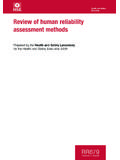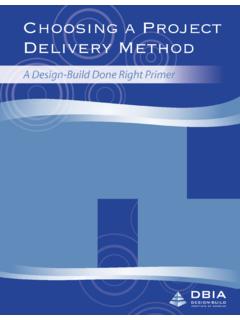Transcription of Advantages and Disadvantages of Various Randomized ...
1 Advantages and Disadvantages of Various Randomized Clinical Trial Designs Brian Leroux University of Washington IADR/AADR Satellite Symposium: Updates in Clinical Research Methodology March 18, 2013 Supported by NIDCR grants DE016750, DE016752. 1 Outline Introduction Why randomize? History and use of RCTs Phases of RCTs Clinical trial designs Completely Randomized design Stratified design Cross-over design, split-mouth design Cluster Randomized design Cluster-crossover design Step-wedge design How to choose a design - Examples 2 Why Randomize? Random assignment of patients to treatments provides the strongest possible basis for inference about treatment effects. To take advantage of this we perform an Intent-to-Treat Analysis: patients are analyzed according to their random treatment assignment, , the intended treatment, not the treatment actually received. 3 History of RCTs 1880s First Randomized experiments in psychic research* 1925 Fisher s lady tasting tea^ 1948 First published medical RCT& 1968 One of the earliest dental RCTs# # RCT publications: in Medline: 340,000 in Dental journals: 10,000 *Hacking, I (1988).
2 ISIS 79(3):427-451. ^Fisher, (1925). Statistical Methods for Research Workers. & Medical Research Council (1948). BMJ 2:769-782. # Ramfjord et al. (1968). J Periodontol. 39(3):167- 4 Studies Registered in 5 # Studies in by Topic Topic # Studies* Gingivitis 377 Periodontitis 321 Oral Cancer 248 Caries 206 Dental Implants 131 Restorative Dentistry 98 TMD 90 Maxillofacial Surgery 84 Orthodontics 75 Cleft Lip/Palate 48 Endodontics 36 * Not necessarily unique studies. 6 Growth of RCTs 1975198019851990199520002005201011010010 0010000# RCT Publications 1975-2011 YearNumber of PublicationsAll MedlineDentistry769201537 Citations of Dental RCTs* * Web of Science, articles published 1975-2011. Average citations per article: 15, h-index: 74. 8 Average # Citations by Field Field # RCT Articles Average # Citations per Article Opthalmology 4445 22 Geriatrics 4365 20 Transplantation 3656 22 Dentistry 3317 15 Nursing 3287 10 Microbiology 3039 32 Health Policy 3010 17 Dermatology 2994 18 Psychology 2739 24 Reproductive Biology 2603 19 9 Phases of Clinical/Translational Research Phase 0 basic science & animal studies Phase 1 small trials to explore biological activity and safety (possibly unrandomized) Phase 2 medium-sized trials to explore treatment effect on surrogate outcomes Phase 3 large trials to provide definitive evidence of treatment effect on clinical outcomes Phase meta-analyses of RCTs Phase 4 observational studies in real world 10 RCT Designs The defining feature of an RCT design is the way in which the random assignment of treatments is performed.
3 There are many ways to randomize! by patient, by clinic, by tooth, .. 11 Main Types of RCT Designs Completely Randomized Stratified Cross-over Cluster- Randomized Cluster-crossover Step-wedge 12 Completely Randomized RCT Recruit sample of patients and randomize 13 Pros and Cons of Completely Randomized Design +Relatively simple to execute -May be less efficient than other designs 14 Example Phase I RCT of Glycine Powder Air Polishing in Periodontal Pockets* Comparison of sub-gingival air polishing with glycine powder vs scaling and root planing Completely Randomized (n=15 per group) By chance, there was a surprising imbalance between groups in gender, which didn t appear to affect results (but is a good example of why stratification is useful) * Flemmig et al. (2012). J. Periodontology 83(4):444-452. 15 Sample Size Calculation for Completely Randomized Design Outcome = change in average total bacterial count on log scale, in moderate-deep pockets Based on previous similar study hypothesized difference of 1 (on log scale) SD = N = 2 [( + ) ]2 = 12 patients per group for power 80%, type I error * Enroll 15 per group to allow for missing data and correct for small sample^ *General formula: N = 2 [(z_a + z_b) / ]2 ^ Formula for N is a large-sample approximation.
4 16 Completely Randomized Design for Glycine Powder RCT N=30 Patients Randomization Glycine Powder 15 patients SRP 15 patients 17 Stratified RCT Recruit samples of patients within strata and randomize within strata. 18 Pros and Cons of Stratified Randomized Design +Gain in precision compare treatments within strata, so variation between strata is eliminated +Treatment groups guaranteed to be fairly well balanced on stratum characteristics +Can compare treatment effects across strata -Can be difficult to implement need to know stratification variables before randomization 19 Example Treatment of White Spot Lesions for Orthodontic Patients* Comparison of 1) MI Paste Plus 2) Fluoride varnish 3) Regular home care Randomization stratified by dental practice and time since band removal (< 2 months versus 2 months or more prior to randomization) * Huang GJ et al. (2013). Amer J Orthodont Dent Orthoped 143(1):31-41.
5 ( # NCT 01059058) 20 Sample Size Calculation for White Spot Lesions Trial Outcome = 8-week % improvement in WSL assessed by blinded examiners using VAS Difference desired to detect = 20% Within-stratum SD = 25%* Type I error , power=80% for pairwise comparisons N = 2 [( + ) 25/20]2 = 30 Enrollment target: 40 per group Aim for 40 per group for both < 2 and 2 months, to be able to detect treatment effects separately * Note: The overall SD may be higher than this. 21 Stratified Randomized Design N=240 Patients Randomization Fl. Varnish (n=40) Home Care (n=40) MI Paste (n=40) Randomization Fl. Varnish (n=40) Home Care (n=40) MI Paste (n=40) Debanded 2 mos. (120) Debanded < 2 mos. (120) 22 Results for WSL RCT No evidence for difference between treatments. MI Paste Fl. Varnish Home Care (N=34) (N=40) (N=41) Improvement*, mean (SD) ( ) ( ) ( ) *As assessed by expert panel.
6 Similar results for lay panel, self-assessment and objective measure. 95% CI for difference: MI vs Home Care: ( , ) Fl. Varnish vs Home Care: ( , ) 23 Crossover Design All patients receive both treatments. Randomize patients to order of treatments. Period 1 Period 2 Patient 1 C T Patient 2 C T Patient 3 T C Patient 4 C C Patient 5 C T Patient 6 T C Patient 7 T C Patient 8 C T 24 Pros and Cons of Crossover Design +Gain in precision compare treatments within patients, so variation between patients is eliminated -Susceptible to carry-over effects (lasting effects of one treatment on outcome in the following period), which can invalidate the results 25 Sample Size Calculation for Cross-over Design The design effect (DEFF) tells you the reduction in required sample size due to correlation between measures on same patient Design effect = 1 = correlation between outcomes on same patient Required N = Na ve N (1 ) Example (Glycine powder air polishing).
7 N = 12 (1 ) = So need 10 patients with 2 periods each But enroll 14 patients to account for dropout 26 Crossover Design N=14 Patients Randomization Control (N=7) Outcome: 5 Patients Treatment (N=7) Outcome: 5 Patients Control (N=7) FU: 5 Patients Treatment (N=7) FU: 5 Patients WASH-OUT PERIOD Treatment:14 pats. (10 with FU) { Control: 14 pats. (10 with FU) } Need follow-up on at least 10 patients (2 periods each) 27 Split-Mouth Design All patients receive both treatments in different teeth. Randomize teeth within patients. Warning: carry-over effects may invalidate results.* Tooth 1 Tooth 2 Patient 1 C T Patient 2 C T Patient 3 T C Patient 4 C C Patient 5 C T Patient 6 T C Patient 7 T C Patient 8 C T *Lesaffre et al. (2009). Statist Med 28(28):3470-3482. Hujoel (1998). Comm Dent Oral Epi 26(2):85-86. 28 Cluster- Randomized RCT Recruit a sample of clusters of patients (clinics, communities, etc.)
8 And randomize the clusters. 29 Pros and Cons of Cluster- Randomized Design +Prevents contamination between individuals assigned to different treatments (patient or provider) +Useful for group-level interventions +Useful when individual randomization is impossible -Can be much less efficient than individual- Randomized designs 30 Example: PRECEDENT Pulp Capping RCT* MTA vs CaOH for direct pulp capping Reasons for cluster randomization: Emergency procedure so not feasible to randomize individual patients Practice effects could contaminate results if Randomized individual patients * # NCT00812877 31 Sample Size Calculation for Pulp Capping RCT Outcome = failure within 2 years Failure probability vs. Type I error , power = 90% Ignoring clustering: N = [ {2(.225)( )}1/2 + {.15( )+.3( )}1/2 / ] 2 = 161* *In general: N = ( [z_a {2p(1-p)}1/2 + z_b {p1(1-p1)+p2(1-p2)}1/2]/[p1-p2] )2 32 Accounting for Clustering (Design Effect) The design effect (DEFF) tells you how much to inflate N to account for clustering DEFF = 1 + (m-1) ICC m = average # patients per group (assume 13) ICC = intracluster correlation = (see next slide) Design effect = 1 + (13 1) = N = Na ve N DEFF = 161 = 258 Need 20 dentists per group (13 patients/dentist) to have 20 13 = 260 258 patients.
9 So enroll 16 patients per office (allow loss of 3) * Murray, D. Group Randomized Trials. 33 How to estimate the ICC ICC = correlation between outcomes on 2 patients in same dental practice Prior PRECEDENT studies showed that ICC varies greatly with type of outcome: Process variables ( , use of amalgam): ICC sometimes quite large, , Disease outcome variable: ICC often in range to Used ICC= for planning pulp cap trial 34 Cluster- Randomized Design for Pulp Cap Trial N=40 Dentists Randomization of Dentists MTA (N=20 Dentists) 16 patients/DDS Total: 320 Patients CaOH (N=20 Dentists) 16 patients/DDS Total: 320 Patients Follow-Up (260 Patients) Follow-Up (260 Patients) Need follow-up on total of 520 patients, 260 per treatment. 35 A Stratified Design for Pulp Cap Trial (if it was feasible) N=400 Patients 40 DDS 10 patients/DDS Randomization within Dentist MTA 200 patients (5/DDS) CaOH 200 patients (5/DDS) Follow-Up (N=161) Follow-Up (N=161) Need follow-up on total of 322 patients, 161 per treatment.
10 36 Cluster-Crossover RCT Clusters are Randomized to treatments, outcomes measured, then clusters cross-over to other treatment. PER I OD 1 PER I OD 2 37 Pros and Cons of Cluster-Crossover Randomized Design +Recovers loss of efficiency due to clustering -Susceptible to carry-over effects (like patient crossover design) -Doubles length of trial 38 Example: PRECEDENT Pulp Capping RCT Cluster-crossover maintains Advantages of the clustered design but recovers some of the loss of power due to clustering of patients by practice Sample size calculation now depends on two correlations: ICC = correlation between outcomes in the same practice in the same period IPC = correlation between outcomes in the same practice but different periods 39 How big is the IPC? IPC = correlation between outcomes on 2 patients in same dental practice in different treatment periods Reasonable to assume 0 < IPC ICC Greatest benefit from cluster-crossover if IPC=ICC Least benefit if IPC=0 When planning a CC trial best to use this unless you have good prior estimate, eg, from a pilot trial 40 Cluster-Crossover Design for Pulp Cap RCT N=40 Dentists Randomization of Dentists CaOH (N=20 DDS) (120 Patients) FU: 100 Patients (5/DDS) MTA (N=20 DDS) (120 Patients) FU: 100 Patients (5/DDS) CaOH (N=20 Dentists) (120 Patients) FU: 100 Patients (5/DDS) MTA (N=20 Dentists) (120 Patients) FU: 100 Patients (5/DDS) WASH-OUT PERIOD MTA:Total 200 pats.






